Small Trees for Small Yards (With Pictures): Identification Guide
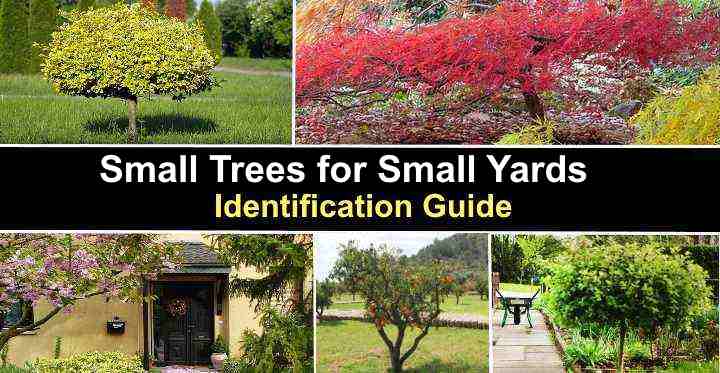
Small trees are the ideal choice for landscaping a small yard. Ornamental trees that don’t grow taller than 15 ft. (4.5 m) look stunning in a front yard where space is limited, and you can enhance curb appeal at the same time. Additionally, small evergreen trees and deciduous trees can help enhance the landscape of a compact backyard. You can also introduce a splash of color and floral scents to your garden landscape by planting compact decorative flowering trees.
Small ornamental trees are ideal for landscaping tight spaces in a front or backyard. For example, many compact evergreen conifers like Lawson cypress or white spruce have a low footprint and columnar habit. Additionally, dwarf flowering trees like crabapple, cherry blossom, dogwood, and redbud produce masses of spectacular blooms in spring and summer.
What are the best small trees suitable for a compact garden landscape? The article identifies the best trees that do not take up much space in a front or backyard.
What Are Small Trees for Compact Yards?
Compact yards can benefit from planting small trees to provide vertical accents, shade, leafy foliage, and colorful flowers, enhancing aesthetics. The best small trees for small yards mature at 10 to 15 ft. (3 – 4.5 m) in height. These trees with limited height ensure they never encroach on your property or your neighbor’s yard.
Dwarf tree varieties such as Japanese maples, flowering dogwoods, redbuds, and crape myrtles are all good options for small yards. By carefully selecting types of trees suited to your space and USDA growing zone, you can help create an attractive and inviting atmosphere in your compact front or backyard.
How to Choose Small Trees for Small Front or Backyards
Apart from height, several factors affect the species of small trees suitable for a front yard or backyard. Before planting a decorative tree, check its growing zone, sunlight levels, and water requirements. Additionally, consider the tree’s spread. Some dwarf trees, like flowering fruit trees, have a widely spreading canopy.
Small Trees for Small Yards (With Pictures)
What are the best small trees for compact front and backyards? Please read on to learn about 18 trees that look beautiful in a garden without taking up too much room. Many of these trees are ideal lawn trees or decorative trees for planting in a flower bed.
Small Crabapple Trees (Malus)

Choose a dwarf type of crabapple tree to add a stunning floral display in a small garden
Dwarf crabapple trees are the perfect choice for small yards and gardens. These small trees blossom with abundant clusters of white and pink spring flowers. The small flowers emit strong floral aromas as they blossom before the leaves appear. After flowering, small pomes or crabapples appear before the foliage turns red, burgundy, and orange in the fall.
Many varieties of crabapple trees have a compact size, making them easy to maintain. Dwarf crabapple trees grow 8 to 10 ft. (2.4 – 3 m) tall and wide. The fruit-bearing flowering trees thrive in full sun and well-drained soil. They are an ideal choice of tree to beautify a backyard in zones 4 to 8.
Not all crabapple trees are small, compact trees for growing in limited space. The varieties that have a mature height under 15 ft. (4.5 m) are the following:
- Crabapple Malus ‘Adams’
- Crabapple Malus ‘Camelot’
- Crabapple Malus ‘Coralburst’
- Crabapple Malus ‘Louisa’
- Crabapple Malus ‘Sargentii’
Mature Size: Up to 15 ft. (4.5 m)
USDA Hardiness Zones: 4 to 8
Sun: Full sun
Related reading: Varieties of crabapple trees.
Dwarf Flowering Cherry Tree (Prunus)

The dwarf flowering Fuji cherry tree (Prunus incisa ‘Kojo-No-Mai’) matures to around 8 ft. (2.4 m) in both height and width and is compact enough to be grown in a container
Dwarf flowering cherry trees are highly ornamental trees that grow in limited spaces. Ideal for small gardens, decorative cherry trees have pink or vibrant white saucer-shaped flowers growing in dense clusters. The ovate leaves emerge coppery-bronze before turning dark green, then orange and red in the fall.
Depending on the species, some small cherry blossom trees have showy pink double flowers blooming in drooping clusters. Other dwarf cherry trees have weeping branches with white star-shaped flowers. Additionally, the ornamental cherry trees produce small pea-sized drupes, adding to their decorative appeal for gardens with limited space.
Dwarf cherry trees grow 7 to 15 ft. (2.1 – 4.5 m) tall and wide. These easy-to-prune trees are perfect for a backyard, growing as a lawn tree or in a container. They are suitable for USDA zones 6 to 8.
Mature Size: 7 to 15 ft. (2.1 – 4.5 m) tall and wide
USDA Hardiness Zones: 6 to 8
Sun: Full sun
Japanese Weeping Cherry (Prunus serrulata ‘Kiku-Shidare-Zakura’)
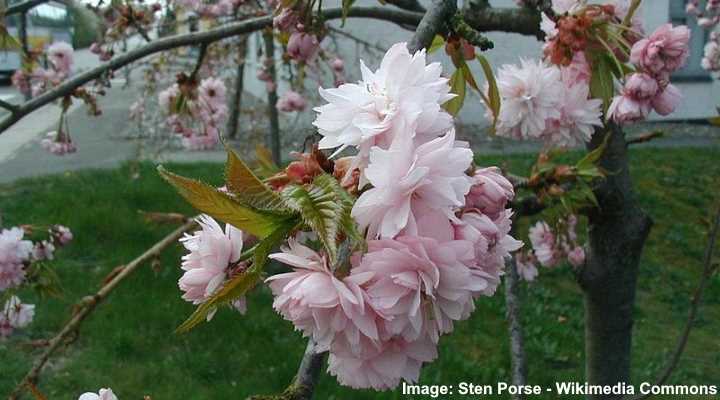
Japanese weeping cherry ‘Kiku-Shidare-Zakura’ has stunning ruffled pink flowers and is great for compact spaces
The Japanese weeping cherry tree ‘Kiku-Shidare-Zakura’ is one of the most spectacular small trees for a small garden landscape. The beautiful tree grows up to 15 ft. (4.5 m) tall. Its cascading, arching branches are covered in double, rich pink blossoms, each with 125 petals in the flower head.
This small weeping flowering tree grows 10 to 15 ft. (3 – 4.5 m) tall and wide. Its pendulous branches, stunning pink flowers, and luscious green foliage look spectacular in a small yard. Landscaping ideas for this small tree include a lawn specimen or a tree for flower beds.
The Japanese weeping tree thrives in USDA zones 4 to 9.
Mature Size: 10 to 15 ft. (3 – 4.5 m) tall and wide
USDA Hardiness Zones: 4 to 9
Sun: Full sun to light shade
Purple Leaf Sand Cherry (Prunus × cistena)

The small purple leaf sand cherry has stunning pink flowers and colorful foliage
The purple leaf sand cherry is a small ornamental tree or deciduous shrub that is a great choice for adding a pop of color to a small yard. This dwarf tree is known for its reddish-purple leaves, small pinkish-white flowers, and beautiful fall colors. Purple-leaf sand cherry trees reach a height and width of 6 to 10 ft. (1.8 – 3 m).
Purple leaf sand cherry trees are perfect for planting in your small garden as an ornamental bush, vibrant fence, unique focal point, or in group plantings. They grow best in full sun and soil that is well-draining. This ornamental tree thrives in USDA zones 2 to 8.
Mature Size: 6 to 10 ft. (1.8 – 3 m)
USDA Hardiness Zones: 2 to 8
Sun: Full sun
Chinese Plum Tree (Prunus glandulosa)
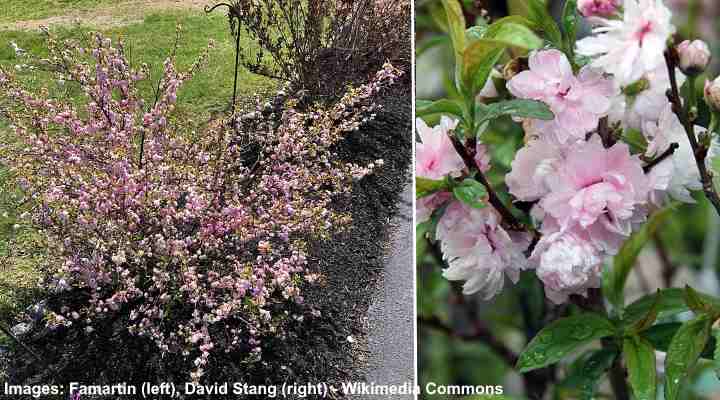
The Chinese plum tree is a small ornamental tree with a shrub-like, spiky growth habit. The tree is popular for its stunning clusters of fragrant, white or pink, single or double flowers that bloom in spring. This decorative tree has alternate, oval-shaped leaves that turn into a yellow hue during autumn. Additionally, it produces small red cherries that beautifully contrast against the medium-green foliage, enhancing its visual appeal.
Chinese plum trees thrive in well-drained, loamy soils. This pink-flowering tree can serve as a striking focal point or a beautiful accent plant in your small yard. With its attractive flowers and appealing shape, this tree is guaranteed to enhance the overall appearance of your small garden.
Mature Size: 4 to 5 ft. (1.2 – 1.5 m) tall and wide
USDA Hardiness Zones: 4 to 8
Sun: Full sun to partial shade
Frangipani (Plumeria)
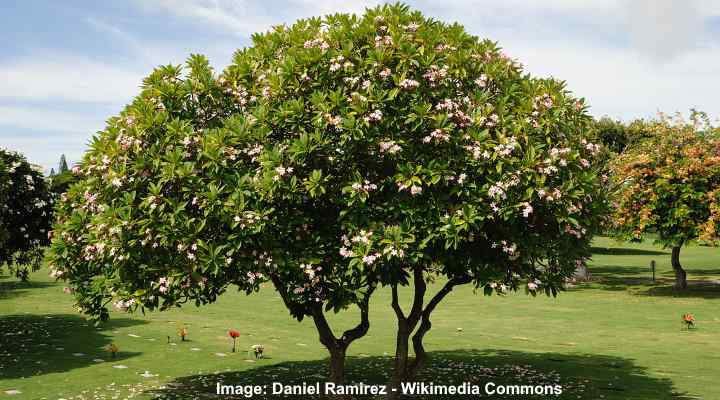
If you live in a warmer zone you can choose a small frangipani variety to suit a tight space
Many varieties of frangipani trees are small enough to grow as lawn trees in a compact open space. The small deciduous tree has large, fragrant flowers with vibrant red, orange, white or yellow petals. These flowers grow 3” (7.5 cm) wide and have a strong, floral fragrance. Frangipani trees also have leathery green leaves growing spirally on woody stems.
Perfect for small yards or outdoor gardens in tropical and subtropical climates, dwarf frangipani trees grow to heights of 10 to 15 ft. (3 – 4.5 m). These decorative trees thrive in beds and borders, as well as containers, and they are tolerant of drought and salty coastal air.
Mature Size: 10 to 15 ft. (3 – 4.5 m)
USDA Hardiness Zones: 10 to 12
Sun: Full sun
Roughleaf Dogwood (Cornus drummondii)
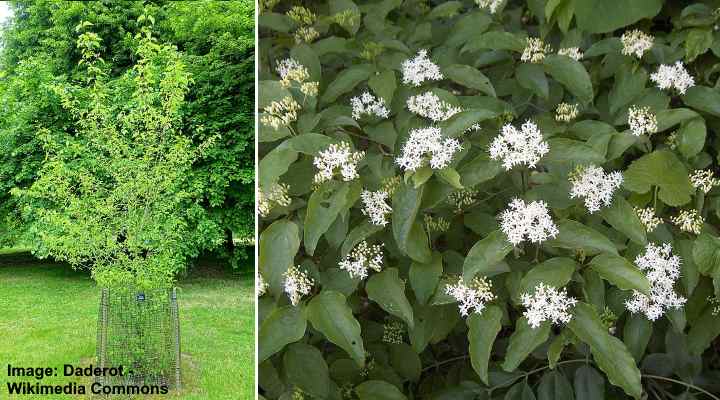
Roughleaf dogwood (Cornus drummondii) young tree (left), leaves and flowers (right)
Roughleaf dogwood is a small tree with shrub-like growth that is a great choice for smaller yards. This deciduous tree has lovely creamy-white blooms growing in flat-topped clusters. From spring through fall, dark green foliage decorates the small tree before turning shades of red and purple in the fall.
Roughleaf dogwood trees have multi-season appeal—white spring flowers, lush summer foliage, striking fall colors, and an attractive shape in winter. Suitable for USDA zones 5 to 8, this dogwood variety grows 6 to 15 ft. (1.8 – 4.5 m) tall and wide. You can plant the shrub-like tree in full sun, and it also tolerates marshy soils.
Mature Size: 6 to 15 ft. (1.8 – 4.5 m) tall and wide
USDA Hardiness Zones: 5 to 8
Sun: Full sun
Related reading: Dogwood trees with red berries.
Pink Flowering Japanese Dogwood (Cornus kousa ‘Miss Satomi’)
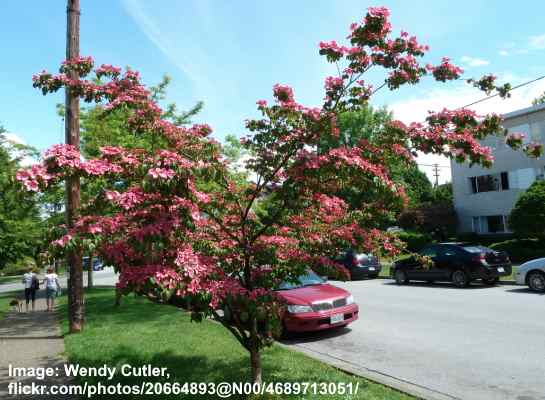
The Japanese pink flowering dogwood tree is an attractive landscaping tree for small spaces
Japanese dogwood’ Miss Satomi’ is an outstanding, small flowering tree with a rounded crown and beautiful pink spring flowers. The ornamental value of this small deciduous tree is its deep pink flower-like bracts, rosy-pink summer fruits that look like round strawberries, and stunning red and scarlet fall colors.
Kousa dogwood’ Miss Satomi’ grows 12 to 15 ft. (3.6 – 4.5 m) tall and wide. Its compact growth, lush foliage, and pink flowers make it perfect as a specimen or lawn plant in compact front or back yards. Suitable for growing in USDA zones 5 to 8.
Mature Size: 12 to 15 ft. (3.6 – 4.5 m) tall and wide
USDA Hardiness Zones: 5 to 8
Sun: Full sun
Dwarf Japanese Maples (Acer palmatum)

Laceleaf Japanese maple ‘Garnet’ (Acer palmatum var. dissectum ‘Garnet’) is a dwarf tree growing to 8 ft. (2.4 m) tall which is great for landscaping limited spaces
Small, ornamental Japanese maple trees are perfect for gardens with limited space as they grow around 10 ft. (3 m) tall. These decorative maples are renowned for their ribbon-like palmate or deeply lobed leaves. Japanese maple leaves emerge dark red and turn shades of green or red through the season, depending on the cultivar.
The best small Japanese maples for compact yards grow 6 to 12 ft. (1.8 – 3.6 m) tall and up to 12 ft. (3.6 m) wide. The low-maintenance trees thrive in full sun or partial shade and moist, well-drained soil. They perform best in USDA zones 5 to 9.
Mature Size: 6 to 12 ft. (1.8 – 3.6 m) tall and up to 12 ft. (3.6 m) wide
USDA Hardiness Zones: 5 to 9
Sun: Full sun to partial shade
Fernleaf Full Moon Maple (Acer japonicum ‘Aconitifolium’)
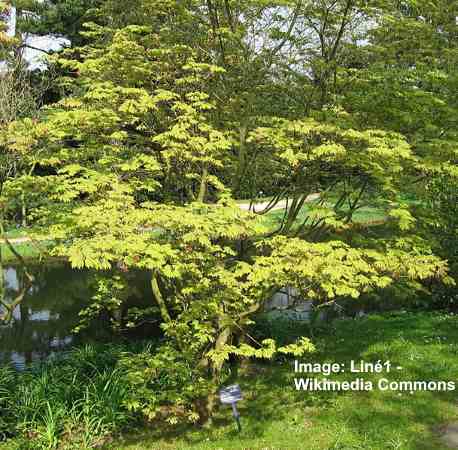
The dwarf ornamental fernleaf full moon maple is a compact deciduous tree with attractive feathery foliage and autumn color
The Japanese maple is a highly decorative dwarf tree perfect for planting in a small yard or compact space. The tree’s leaves transition into beautiful hues of crimson red, yellow, and orange in the fall, adding to its ornamental appeal. This slow-growing tree features medium-green, fern-like leaves, each with 7 to 11 pointed lobes. Other identifying features include small red flowers, winged maple seeds, and a compact, upright branching habit.
The ornamental Japanese maple ‘Aconitifolium’ can grow 8 to 10 ft. (2.4 – 3 m) tall and wide. With its compact size, lovely flowers, and decorative leaves, this low-maintenance tree is perfect for planting in small yards as a focal point, accent plant, or specimen tree. Consider this small maple tree if you aim to incorporate some color and texture into your autumn garden.
Mature Size: 8 to 10 ft. (2.4 – 3 m)
USDA Hardiness Zones: 5 to 7
Sun: Full sun to partial shade
Related reading: A list of dwarf Japanese maples for small yards.
Fringe Tree (Chionanthus virginicus)

The small deciduous and hardy fringe tree has white scented flowers
Growing a fringe tree in a small, compact yard will provide color, beauty, and delicate fragrances. This small deciduous white-flowering tree has blooms of creamy-white blossoms that give the tree a fuzzy appearance. The ornamental tree has slender, silvery-gray leaves that turn golden yellow in the fall.
Native to the eastern United States, the eye-catching fringe tree thrives in full sun or partial shade in USDA zones 3 to 9. It grows 12 to 20 ft. (3.6 – 6 m) tall and wide and performs well in urban landscapes.
Mature Size: 12 to 20 ft. (3.6 – 6 m) tall and wide
USDA Hardiness Zones: 3 to 9
Sun: Full sun or partial shade
Dwarf Weeping Mulberry (Morus alba ‘Chaparral’ and Morus alba ‘Pendula’)
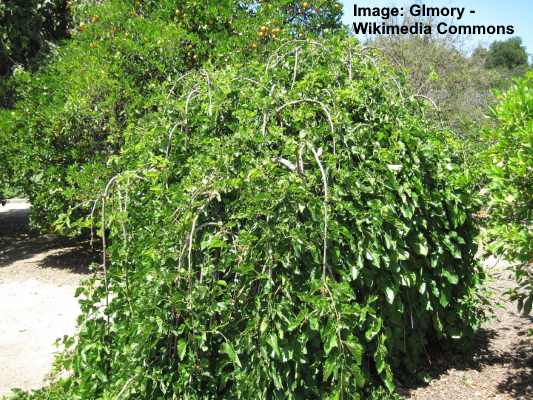
Weeping mulberry (Morus alba ‘Pendula’) is a type of dwarf weeping mulberry that adds ornamental value to small gardens
Dwarf weeping mulberry trees are elegant landscaping trees with arching branches that droop to the ground. These small trees have a neat, rounded crown, and are suitable for small gardens or as a specimen plant.
The mulberry cultivar ‘Chaparral’ is a small flowering tree with drooping branches that reach the ground. Other ornamental features of the tree are its whitish-green flowers and heart-shaped green leaves that turn golden yellow in the fall.
The dwarf weeping mulberry ‘Chaparral’ grows 6 to 8 ft. (1.8 – 2.4 m) tall and wide. Perfect for compact gardens or as an accent tree, the mulberry tree thrives in USDA zones 4 to 8.
The cultivar ‘Chaparral’ is the male species that is non-fruiting. However, if you want to enjoy delicious fruits in your small backyard, then choose the female tree Morus alba ‘Pendula.’ This weeping mulberry tree grows 6 to 10 ft. (1.8 – 3 m) tall and up to 12 ft. (3.6 m) wide. It is also easy to maintain, and its beauty enhances a compact outdoor space.
Mature Size: 6 to 8 ft. (1.8 – 2.4 m) tall and wide
USDA Hardiness Zones: 4 to 8
Sun: Full sun
Crape Myrtle (Lagerstroemia)
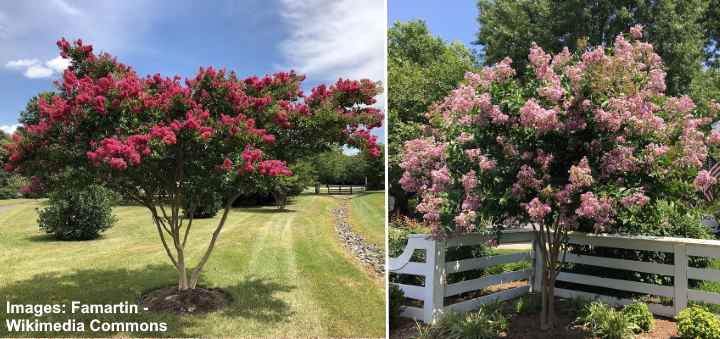
Crape myrtles are small flowering trees that grow best in full sun and are suitable for compact spaces
Crape myrtle is a group of stunning ornamental trees ideal for small front gardens. The outstanding feature of the small tree is its large clusters packed with fragrant pink, red, or white flowers. These showy blooms measure 6” to 9” (15 – 20 cm) long and appear in midsummer, covering the small tree’s vase-shaped canopy.
Crape myrtle decorative trees perform best in USDA zones 6 to 9 in full sun. Apart from growing as an ornamental tree in a small yard, they grow well as foundation plantings, privacy screens, or informal hedges. Most small crepe myrtle trees grow 8 to 15 ft. (2.4 – 4.5 m) tall.
Mature Size: 8 to 15 ft. (2.4 – 4.5 m)
USDA Hardiness Zones: 6 to 9
Sun: Full sun
Related reading: How to care for crape myrtle trees.
Dwarf Serviceberry (Amelanchier ‘La Paloma’)

The white flowers of the dwarf serviceberry tree add ornamental value to compact gardens
Serviceberry is a small deciduous flowering tree with abundant sprays of attractive white spring flowers. After the fragrant white flowers emerge on bare branches, small green oval leaves appear, followed by small red to dark purple-black edible berries. In the fall, the small tree transforms into stunning hues of red and orange.
Serviceberry trees have multi-season landscaping options for small yards. Apart from filling a compact front yard with attractive flowers and foliage, the tree has an elegant growth habit with charcoal-gray grooves in winter. Ideal for small yards, serviceberry trees grow 8 to 15 ft. (2.4 – 4.5 m) tall and wide.
Serviceberries are suitable for growing in USDA zones 4 through 8.
Mature Size: 8 to 15 ft. (2.4 – 4.5 m) tall and wide
USDA Hardiness Zones: 4 to 8
Sun: Full sun to partial shade
Saucer Magnolia ‘Lilliputian’ (Magnolia soulangeana ‘Lilliputian’)
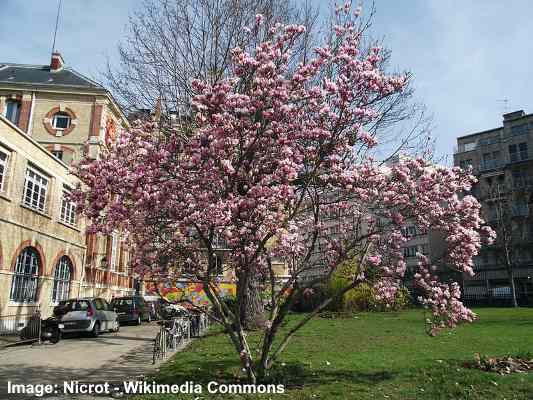
Saucer magnolia ‘Lilliputian’ is a small tree with stunning pink flowers and is versatile enough for landscaping small yards
The saucer magnolia cultivar ‘Lilliputian’ is a slow-growing deciduous tree with large fragrant cup-shaped spring blooms. The spectacular tree has an upright, pyramidal habit. It produces fragrant pale-pink bi-colored flowers that have a citrusy aroma. After flowers appear, large gray-green leaves emerge in late spring.
Thanks to its compact size, ‘Lilliputian’ is the most popular dwarf magnolia for small front and back yards. These sun-loving trees grow 10 to 12 ft. (3 – 3.6 m) tall and up to 8 ft. (2.4 m) wide. USDA zones 5 to 9.
A dwarf saucer magnolia tree is ideal for a small landscape garden as a specimen plant, a flowering tree in a city garden, or to create a focal point in a front yard.
Mature Size: 10 to 12 ft. (3 – 3.6 m) tall and up to 8 ft. (2.4 m) wide
USDA Hardiness Zones: 5 to 9
Sun: Full sun
Star Magnolia (Magnolia stellata)
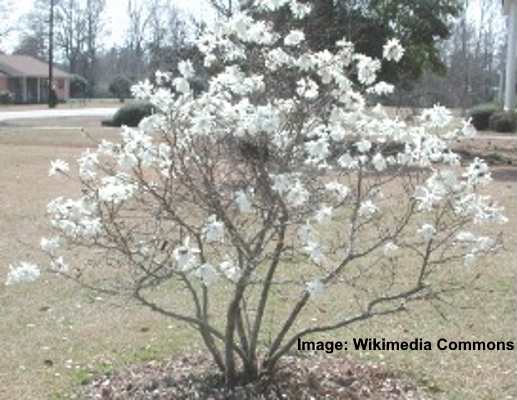
The small flowering star magnolia tree is a beautiful ornamental tree with white fragrant flowers
Star magnolia is an ideal ornamental tree with showy white or pink star-shaped flowers. The small shrub-like tree looks stunning in a compact front yard with its pink flower buds that open into masses of pure white, showy blooms with ruffled, linear petals. In winter, the bare branches are covered with furry buds, adding to its ornamental appeal.
Dwarf star magnolias, such as the cultivars ‘King Rose Star,’ ‘Centennial Bush,’ and ‘Royal Star,’ grow to heights of 10 to 15 ft. (3 – 4.5 m). They thrive in full sun or partial shade in USDA hardiness zones 4 to 9.
Mature Size: 10 to 15 ft. (3 – 4.5 m)
USDA Hardiness Zones: 4 to 9
Sun: Full sun to partial shade
Eastern Redbud ‘Ace of Hearts’ (Cercis canadensis ‘Ace of Hearts’)
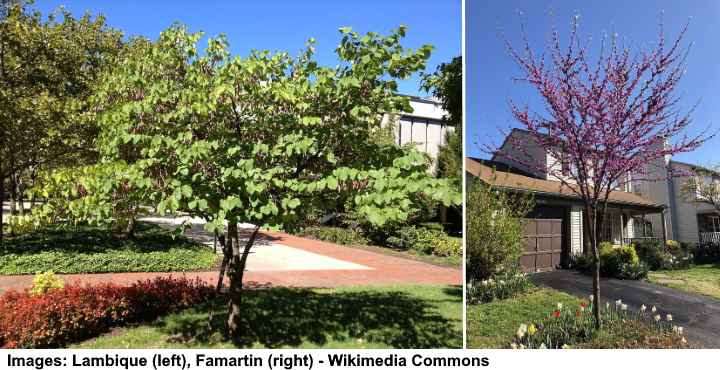
The Eastern redbud trees include several small cultivars for landscaping small gardens
Growing an eastern redbud tree adds a touch of natural beauty to a yard that doesn’t have much room. The outstanding small flowering tree blooms in early spring with abundant clusters of deep purple pea-like flowers on bare branches. After blooming for three weeks, heart-shaped leaves appear that turn yellow in the fall.
The ornamental value in winter to a small yard is enhanced by the redbud’s attractive vase-shaped branching habit. Native to the eastern US, eastern redbuds grow 12 ft. (3.6 m) tall and 15 ft. (4.5 m) wide. They perform best in USDA zones 5 to 9.
Mature Size: 12 ft. (3.6 m) tall and 15 ft. (4.5 m) wide
USDA Hardiness Zones: 5 to 9
Sun: Full sun to partial shade
Weeping Eastern Redbuds (Cercis canadensis ‘Ruby Falls’ and ‘Lavender Twist’)

Eastern redbud ‘Lavender Twist’ (also known as ‘Covey’) is a dwarf weeping tree
Weeping eastern redbuds add stunning visual focal points to a small front yard. These ornamental trees are renowned for their outstanding spring blooms, featuring dark rose or red-rose flowers. Furthermore, they have heart-shaped, dark red leaves. However, it’s the distinctive weeping habit that truly makes these redbuds stand out in compact landscapes.
Ornamental weeping redbud trees grow 5 to 6 ft. (1.5 – 1.8 m) tall and up to 8 ft. (2.4 m) wide. For best results, plant the tree in full sun in a front or back garden, ensuring it gets some shade on the hottest summer days. They thrive in USDA zones 5 to 9.
Mature Size: 5 to 6 ft. (1.5 – 1.8 m) tall and up to 8 ft. (2.4 m) wide
USDA Hardiness Zones: 5 to 9
Sun: Full sun
Dwarf Alberta Spruce (Picea glauca ‘Conica’)
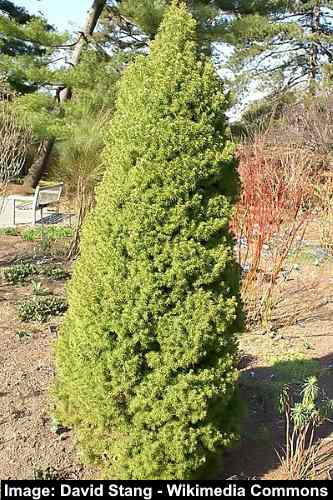
The dwarf Alberta spruce is a small evergreen conifer tree with a conical shape that can be grown in a container
The dwarf Alberta spruce (also called dwarf white spruce) is a small evergreen hardy conifer with a dense, cone-shaped habit. This dwarf tree features soft green aromatic needles that remain throughout the year. Thanks to its hardiness and compact size, the white spruce is ideal for yards where larger trees would grow too tall.
Suitable for USDA zones 2 through 6, the white spruce thrives in full sun. This dwarf coniferous landscaping tree grows 10 to 13 ft. (3 – 4 m) tall and 10 ft. (3 m) wide. You can use the small tree as a foundation plant or evergreen screen, or grow in planters in a container garden.
Mature Size: 10 to 13 ft. (3 – 4 m) tall and 10 ft. (3 m) wide
USDA Hardiness Zones: 2 to 6
Sun: Full sun
Dwarf White Fir (Abies concolor ‘Compacta’)
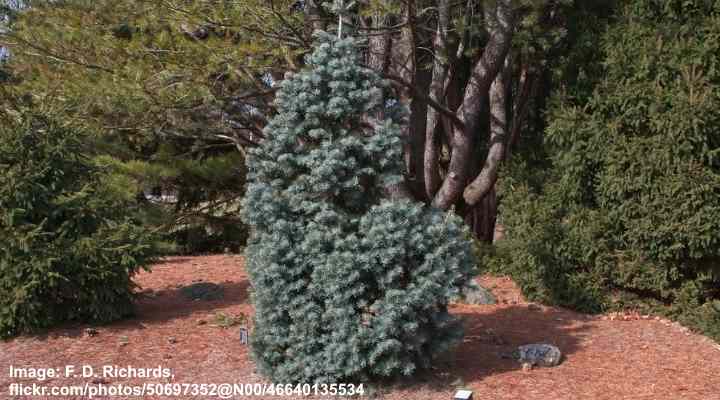
Dwarf white fir looks beautiful in a small landscaped garden with its gray bluish-green foliage
One of the most popular small conifers for compact landscapes is the dwarf white fir tree. The evergreen conifer has a dense, pyramidal shape and attractive blue-green needles. It’s an ideal ornamental tree for small yards in regions with long winters and cool summers.
Dwarf white fir trees grow slowly and reach a mature height of 2 to 5 ft. (0.6 – 1.5 m) tall and 4 ft. (1.2 m) wide. This cold hardy tree is suitable for growing in garden landscapes in USDA zones 4 to 7. In addition, its powder-blue, long slender needles will brighten a compact residential landscape throughout the year.
Mature Size: 2 to 5 ft. (0.6 – 1.5 m) tall and 4 ft. (1.2 m) wide
USDA Hardiness Zones: 4 to 7
Sun: Full sun to partial shade
Lawson Cypress ‘Minima Aurea’ (Chamaecyparis lawsoniana ‘Minima Aurea’)
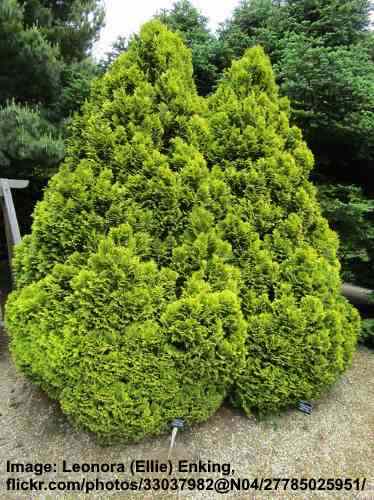
Lawson cypress ‘Minima Aurea’ has attractive golden green foliage and a compact size
Suppose you are searching for vibrant evergreen foliage for a small backyard. In that case, the Lawson cypress cultivar ‘Minima Aurea’ is an ideal choice. This dwarf conifer boasts a dense, pyramidal shape and soft, bright golden-yellow feathery sprays. Lawson cypress dwarf conifers can enhance a sunny border or container garden, or you can cultivate them as a specimen plant.
Lawson cypress ‘Minima Aurea’ is a slow-grower and grows 1 to 5 ft. (0.3 – 1.5 m) tall and only 2 ft. (0.6 m) wide. The small landscaping evergreen tree thrives in USDA zones 5 to 8.
Mature Size: 1 to 5 ft. (0.3 – 1.5 m) tall and only 2 ft. (0.6 m) wide
USDA Hardiness Zones: 5 to 8
Sun: Full sun to partial shade
Pygmy Date Palm (Phoenix roebelenii)
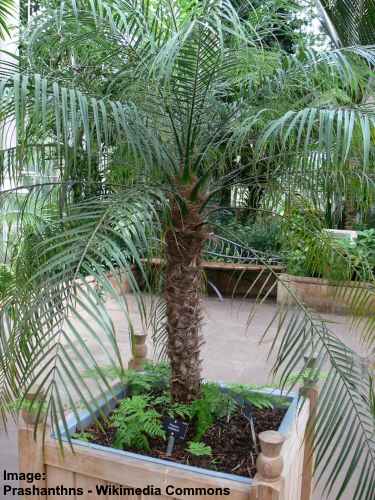
The pygmy date palm is a type of little palm tree with a spiky trunk
The pygmy date palm is the perfect small tree for adding a tropical touch to compact yards. This miniature palm tree is known for its attractive feathery fronds that are 3 ft. (1 m) long. It is also recognized for its long clusters of creamy-yellow flowers and egg-shaped, red-black edible fruits that ripen in late fall.
Pygmy date palms reach a height of around 6 to 10 ft. (1.8 – 3 m). They are also cold-hardy down to 26°F (-3°C). The tree’s compact size makes it a perfect addition for small backyards, front gardens, or even containers. In addition, it’s suitable for planting in pots, making it a great tree for patios and courtyards.
Mature Size: 6 to 10 ft. (1.8 – 3 m)
USDA Hardiness Zones: 9 to 11
Sun: Full sun to partial shade
Sky Pencil Holly (Ilex crenata ‘Sky Pencil’)
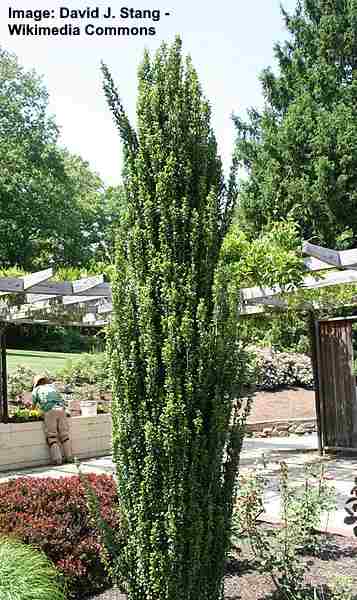
Sky Pencil Holly has a narrow growth habit and is not too tall
The sky pencil holly is a slow-growing evergreen tree with a slender, columnar growth habit. This tree is great for adding some height and visual interest to small yards or compact spaces. This narrow, pencil-thin tree grows 6 to 10 ft. (1.8 – 3 m) tall and up to 3 ft. (1 m) wide. Its shiny, dark green foliage contrasts beautifully against its clusters of tiny white flowers.
The sky pencil holly is a perfect choice for adding a vertical accent to a small garden. The tree is low-maintenance, as well as drought and heat tolerant. Some planting ideas include using it as a corner-of-the-house plant, privacy screen, or foundation plant. The tall, narrow tree also does great in pots or as a stand-alone plant.
Mature Size: 6 to 10 ft. (1.8 – 3 m) tall and 3 ft. (1 m) wide
USDA Hardiness Zones: 6 to 8
Sun: Full sun to partial shade
Small Ornamental Chaste Tree (Vitex agnus-castus)

Chaste Tree (Vitex agnus-castus)
The chaste tree is a compact ornamental tree recognized for its clusters of fragrant lilac flower spires that bloom in summer. Also referred to as the monk’s pepper, this deciduous tree features palmately compound, grayish-green leaves and rounded berries in the fall.
Compact, decorative chaste trees are ideal for planting in small gardens as they only grow to a height of around 8 to 10 ft. (1.8 – 3 m). This tree is tolerant of drought and thrives in cottage gardens, mixed borders, and xeriscapes. The lilac-violet blossoms of this tree also make excellent cut flowers and dried floral displays.
Mature Size: 8 to 10 ft. (1.8 – 3 m)
USDA Hardiness Zones: 7 to 9
Sun: Full sun
Japanese Flowering Quince (Chaenomeles Japonica)
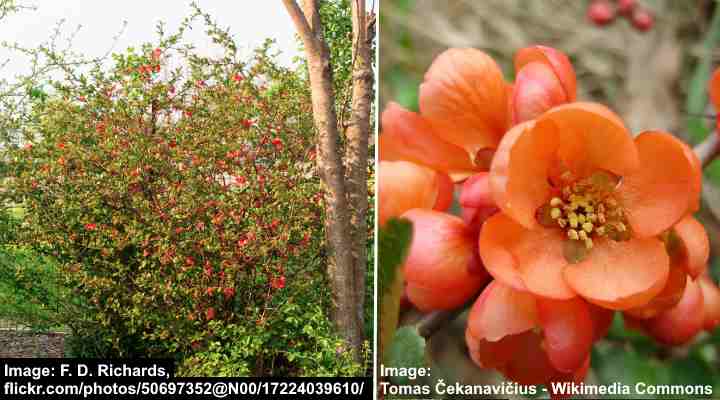
The Japanese flowering quince is a small deciduous tree with shrub-like growth, characterized by its beautiful clusters of orange-red flowers. The five-petaled flowers are cup-shaped and showcase pale-yellow stamens. With its rounded canopy, it adds charm and beauty to small yards. After the flowers fall, the tree gives way to small, golden-yellow to light-green fruits that resemble an apple. The leaves are oval-shaped, glossy, and a shade of medium green.
Although adaptable to many soil types, the Japanese flowering quince tree thrives in well-drained soil. Its remarkable versatility allows for numerous applications in enhancing your small garden. It can serve as a flowering hedge, charming shrub border addition, or as an ornamental specimen plant. The tree can also be used as an excellent security screen around your garden due to its thorn-covered branches.
Mature Size: 2 to 3 ft. (0.6 – 1 m) tall and 3 to 6 ft. (1 – 1.8 m) wide
USDA Hardiness Zones: 5 to 9
Sun: Full sun to partial sun
Yellow Oleander (Cascabela thevetia)

Suitable for a small-scale backyard, the yellow-flowering oleander is a beautiful small tree that can also grow as a multistemmed evergreen shrub. The blossoms are a vibrant golden-yellow color and have a trumpet shape, appearing in small groups at the tips of the branches. Additionally, this yellow-flowering tree features long, leathery green leaves that contrast beautifully with the vibrant yellow blossoms. After the blooming period, the tree produces round, green seed pods that turn reddish-black when ripe.
The yellow oleander thrives in soil that is both damp and well-drained. It’s worth noting that all parts of the tree are toxic, so exercise caution when planting near children or pets. Despite this, its abundant, glossy green leaves and rounded canopy shape make it a superb option for decorative uses in small yards or compact spaces.
Mature Size: Up to 8 ft. (2.4 m) tall and 4 ft. (1.2 m) wide
USDA Hardiness Zones: 8 to 10
Sun: Full sun to partial shade
Weeping Scotch Laburnum (Laburnum alpinum ‘Pendulum’)
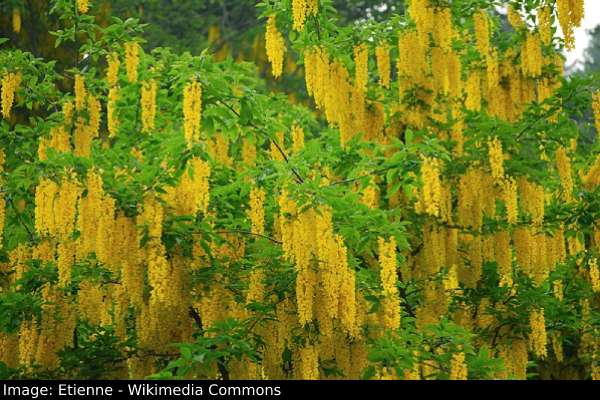
The weeping scotch laburnum is a decorative weeping tree that produces hanging yellow flower clusters in late spring. It also showcases glossy, deep-green leaves that are divided into 3 leaflets. Its umbrella-shaped canopy and lush green foliage are guaranteed to enhance the appearance of your small garden.
For optimal growth, plant the weeping scotch laburnum in well-drained soil. This small, yellow-flowering tree serves as an ideal centerpiece or accent plant. Additionally, its drooping branches and compact size make it a great choice for small gardens or tight spaces.
Mature Size: 6.5 to 8 ft. (2 – 2.5 m) tall and up to 6.5 ft. (2 m) wide
USDA Hardiness Zones: 5 to 7
Sun: Full sun or partial shade
Flame Azalea (Rhododendron calendulaceum)

The flame azalea is a decorative shrub or small deciduous tree perfect for gardens with limited space, as it grows up to 8 ft. (2.4 m) tall. This small decorative shrubby tree is recognized for its vivid orange to reddish-orange star-shaped flowers that are striking in appearance. Its foliage is characterized by elliptic to ovate-shaped leaves with a medium-green hue and a subtly hairy texture on both surfaces. During late autumn, the leaves undergo a stunning transformation, changing to vibrant red or yellow hues before eventually falling
For optimal growth, plant the flame azalea in soil that is both acidic and well-drained, while also maintaining a consistent level of moisture. This beautiful decorative tree is a great choice for use as a flowering hedge, privacy screen, or focal point in your small garden.
Mature Size: 4 to 8 ft. (1.2 – 2.4 m) tall and wide
USDA Hardiness Zones: 5 to 8
Sun: Partial shade or full sun
Waratah (Telopea speciosissima)

The waratah is a small ornamental tree or large shrub known for its vibrant, bright red flower heads that bloom during spring. The flower head’s base showcases sizable ornamental leafy bracts, exhibiting colors that span from red and maroon to pink. The tree also showcases dark green, glossy leaves with serrated edges.
In order for waratah trees to flourish, it is crucial to place them in well-draining soil. These ornamental trees make excellent focal points or specimen trees in small yards due to their slow growth and compact size. With their distinctive flowerhead shape, they are also a great option for cut flower arrangements. For optimal growth, make sure to protect these trees from strong winds, especially when they are young.
Mature Size: 3 to 10 ft. (1 – 3 m) tall and wide
USDA Hardiness Zones: 8 to 10
Sun: Full sun to partial shade
Red Flowering Grevillea Trees
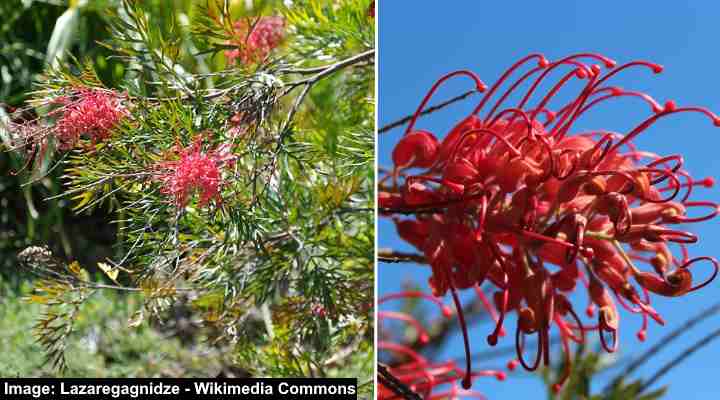
The red flowering grevillea is a compact ornamental tree that can infuse a burst of color into small yards with its spider-like clusters of vibrant red flowers. The red blooms, with their distinctive, slightly-arching petals and long stamens, are sure to add beauty to your small garden. This decorative tree also features evergreen, needle- to fern-like leaves that are dark green to silver-gray in color.
The flowering grevillea tree can grow well in many soil types, as long as they have good drainage. These versatile trees make excellent hedges, screens, or specimen plants, adding both beauty and functionality to your small yard. The tree’s vibrant flowers and ornamental, fern-like leaves are sure to enhance the beauty of your outdoor space.
Mature Size: 4 to 8 ft. (1.2 – 2.4 m) tall, depending on the species
USDA Hardiness Zones: 9 to 11
Sun: Full sun to partial shade
Common Lilac (Syringa vulgaris)
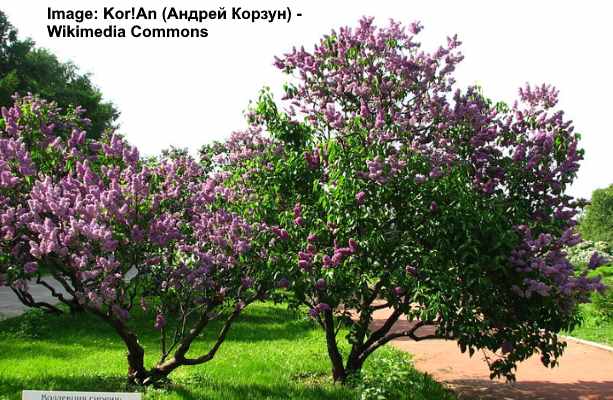
Lilac tree
Ideal for small yards, the common lilac is a beautiful flowering shrub that can be shaped into a small, ornamental tree. It is recognized for its appealing, rounded canopy shape and delightful conical clusters of sweet-smelling, pink-lavender flowers. These multi-colored flowers come in a variety of hues, such as white, purple, or blue. In addition, it features heart-shaped leaves that range in color from bluish-green to dark green, adding a touch of decorative charm to your small yard.
For the best growth, plant the common lilac in fertile, moist, well-drained soil. This shrub-like tree is versatile, and can be planted as a flowering hedge, privacy screen, or focal point. With their attractive, fragrant blooms and lush foliage, they are sure to enhance the beauty of your small garden or compact space.
Mature Size: 8 to 10 ft. (2.4 – 3 m) tall and 5 to 6 ft. (1.5 – 1.8 m) wide
USDA Hardiness Zones: 3 to 8
Sun: Full sun for best flowering
Angel’s Trumpet (Brugmansia suaveolens)
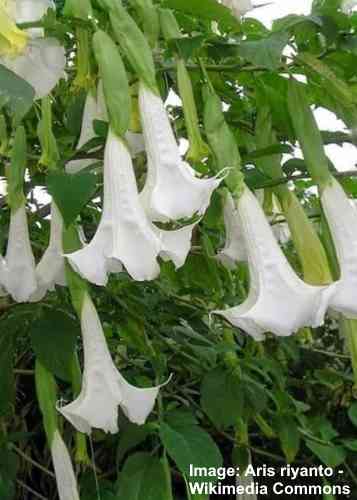
The angel’s trumpet is a small ornamental tree or semi-evergreen shrub that produces large, pendulous, white trumpet-shaped flowers. The tree also features mid-green, oval-shaped leaves that beautifully contrast against the white flowers. Additionally, the tree forms a dense, umbrella-shaped canopy, with branches often spreading further as the tree grows.
The angel’s trumpet grows in fertile soil that is organically rich and well-draining. This white-flowering tree‘s showy blooms are guaranteed to enhance the beauty of your small yard. Its versatility allows it to be used as an excellent specimen tree, accent plant, or even for improving the appearance of garden beds and borders. It’s important to remember that the plant is toxic when ingested, so avoid planting it in areas where children or pets may be around.
Mature Size: 3 to 8 ft. (1 – 2.4 m) tall and 2 to 4 ft. (0.6 – 1 m) wide
USDA Hardiness Zones: 9 to 11
Sun: Full sun or partial shade
Flowering Maple ‘Victor Reiter’ (Abutilon ‘Victor Reiter’)
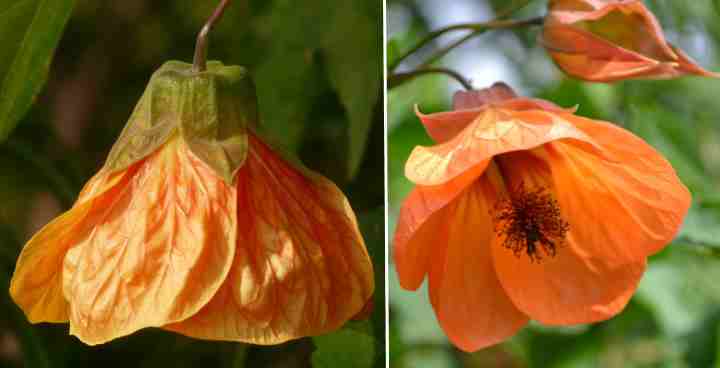
The ‘Victor Reiter’ flowering maple is a small tree or evergreen shrub known for its large, open-facing flowers. Ideal for small gardens, the tree’s charming, pendulous flowers are bell-shaped, and light-orange in color. It also has attractive foliage of lush, dark-green, maple-like leaves that beautifully contrast with the orange blooms.
Flowering maples grow best in rich, moist, well-draining soil that is enriched with organic matter. With their eye-catching peach-colored blossoms and lush foliage, these trees make an excellent ornamental option for adding a burst of color or tropical touch to small spaces.
Mature Size: 6 to 8 ft. (1.8 – 2.4 m) tall and 4 ft. (1.2 m) wide
USDA Hardiness Zones: 9 to 11
Sun: Full sun to partial shade
Related articles:
